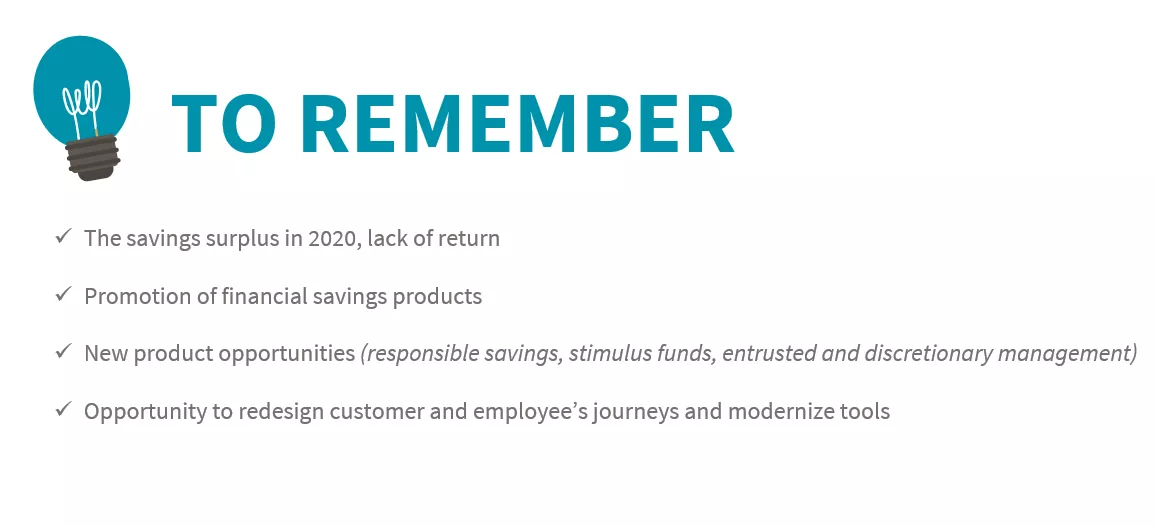2021: the French savings odyssey?
Whether it was constrained or out of precaution, the French savings reached unprecedented levels in 2020. In the health crisis context we are facing, security and liquidity have naturally taken over the search for performance. 2021 will therefore be a savings odyssey for bankers! In the transformation of outstanding balance sheet savings into financial savings, a few interesting leads are worth exploring.

Over the last 5 years, the ECB has implemented a policy of low policy rate which weighs on the bankers’ and insurers’ profitability. The interest rates on the main refinancing operations, the marginal lending facility and the deposit facility are respectively at a 0.00%, 0.25% and a 0.50% level. In short, the cost of money is null or even negative. Costs of credit are logically being reduced, but so are the returns!
The objective of this monetary policy was indeed to renew with growth, but the health crisis marked a halt to this dynamic: the forced savings caused by the sudden consumption halt turned into precautionary savings during the year. The bottom line: the household savings rate will reach an expected 20.3% this year, the highest rate in 40 years according to INSEE!
How can we transform this savings rate, which is at an all-time high? Isn’t it the time for bankers to reinvent themselves on the subject?
2020 lessons
> The Livret A (financial product offered by French banks) was the preferred choice of the French this year. Even if its performance is as its lowest (with a 0.5% floor rate), it has recorded a record level of collections in 2020. At the end of November, net inflows totaled 27 billion euros, doubling the amount collected in 2019 on the same period. Risk-free and liquid, it meets the savers’ expectations in this uncertain period. Widely promoted in the context of low interest rate environment of recent years, it provided a guaranteed return for customers while consolidating the level of regulatory capital, a win-win deal. Nowadays, regulated savings cost the banker more than it brings in.
> Life Insurance, despite being the leading savings vehicle in France, recorded an outflow for 9 months in a row, at a measured level though (minus 30 million euros in November). Gross savings collection remained stable (at around 10 billion euros) with a UL part at around 34%. Considered as an ultimate medium to long-term investment, it has been abandoned by savers in favor of the security and liquidity of deposits and savings account.
> Depostif accounts (i.e. cash accounts) benefited from this with very high levels, reaching 1,106 billion euros last July. In this context of negative interbank rates, banks are obliged to “encourage” their customers to consider more profitable savings solutions or even to discourage excessively high levels of demand deposits, following the example of N26, which taxes deposits of more than 50,000 euros at a rate of 5%.
In the end, French savings could exceed 200 billion euros in 2020 (compared to 143 billion in 2019). This year was therefore exceptional, giving bankers the opportunity to rethink their approach to savings with clients who have little experience.
What do customers want?
First and foremost, customers want to invest in products they understand. However, there are many investment options (securities, envelope products, euro funds, units of account, etc.) and complex product features (taxation, entry and exit fees, management fees, pricing, etc.). The MIFID II regulation, which came into effect in January 2018, imposed the obligation to verify the knowledge (and experience) of the customer in order to protect his interests. This point is still relevant today.
Second, customers want purpose: they want to understand what they are investing in. To this end, in-depth knowledge of product and investment supports is a prerequisite, to which the customer’s aspirations (socially responsible investment, solidarity finance, crowdfunding) are now added, and which banks integrate into their product ranges.
Finally, customers are looking for security and performance, which is a classic paradox. Security implies “minimal risk taking” which will limit returns. It is therefore essential to clearly define the objectives, i.e., the investment horizon of the customer, depending on the customer’s projects, which amounts to a segmentation of a “goal-based investing” type (investment by objective).
These are all elements for reflection that can be used to fuel the customer's savings journeys.
Promoting new savings
While liquid and non-risky savings are still favored by the French, new and promising savings solutions could attract customers:
> Responsible savings, whose offer is still not very mature. A new Eldorado for bankers, it has recently been promoted by the PACTE law (linked to the growth and transformation of companies), which requires the presence of at least one green, SRI, or solidarity unit of account in life insurance contracts. With a growth of 24% last year, even if it still only constitutes 0.29% of household financial savings, proof that customers are looking to combine sense and investment.
> Stimulus funding (notably in the form of local investment funds of FCPI – Fonds commun de placement dans l’innovation) are also solutions that bring meaning to investment, but not without constraints (level of risk, 5-year lock-up). Promoted by the government, they could constitute a lever for the economic rebound, like the BPI private equity fund “BPI Entreprises 1” launched on October 1, 2020.
> The democratization of discretionary portfolio management will undoubtedly be an interesting solution for both customers and bankers. The former will be able to free themselves from product complexity, while the latter will be able to provide services that justify invoicing. It remains to find the right balance between the customer’s desire for personalization and the necessary industrialization of processes via tools that allow volume management. It is therefore a good bet that banks will be offering new savings management offers in an entrusted and delegated mode from this year.
What should the banker do?
To meet customer expectations, the banker’s role will be crucial in promoting and marketing financial savings products.
#1 Bank advisors will have to offer a personalized or even hyper-personalized customer experiencethrough the use of customer data. This relationship will also have to be pedagogical and supported by quality tools: whether they help to better target customers with a high rate of savings conversion, or to offer simulation tools to customers to calculate the costs, tax impact, returns and pricing of certain products.
#2 Banks will have to invest in trainings for their collaborators: technical training on products to better support customers on savings topics – from the very first contact but also to communicate in a synthetic way on the characteristics of each product and “Soft skills” training to gain and maintain customer confidence, a sensitive point where the emotional dimension is often overlooked.
#3 In the area of communication, the efforts of French banks have already been intensified this year, following the example of BNP Paribas, which conducted a campaign on current events in the financial markets and investment strategies, thus helping its customers to become better acquainted with financial savings.
These elements can be integrated into customer journeys, as well as the employees and bank advisors’ journeys. In 2021, banks will have to face many challenges in order to support their customers, recreate a bond of trust that has been distorted for too long, and participate in the economic recovery by promoting investment.
- Interested in change management? Read more

Written by

- Louis de V., Avertim France co-Head

- Cécilia C., Senior Consultant, Banking & Insurance sector
